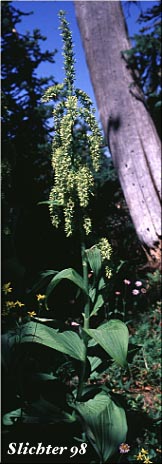 The photo at right shows green false hellebore
and the drooping panicles of its inflorescence.
The photo at right shows green false hellebore
and the drooping panicles of its inflorescence.
The stems are generally single, thick, and erect from one to two meters in height. The stems are glabrous below the inflorescence, softly hairy within the inflorescence.
The numerous leaves are parallel veined, with the basal leaves oblong elliptic in shape and 35 cm long. The leaves are narrower and reduced in size higher on the stem.
The inflorescence is a dense panicle, freely branched, with the lower branches drooping (See photo at right.). The panicle ranges in length from 30 to 70 cm. The flowered branches do not rise as in Veratrum californicum. The six tepals (the petals and sepals look alike) are narrowly oblong-lanceolate to oblong-elliptic in shape, and yellow-green to fairly deep green in tint (with numerous darker green lines running the length of the tepals too). The tepals measure 6-10 mm long and are much longer than the yellowish stamens.
Green false hellebore is a plant of moist areas, from swamps, stream sides, montane meadows, and moist woodlands. It is found from the lowlands into subalpine habitats.
Green False Hellebore is found from Alaska south through the Olympic and Cascade Mts of Washington to the north Cascades of Oregon and eastward to the Rocky Mountains of British Columbia and Alberta and south into Idaho and eastern Washington and Oregon. It may be found further east to Ontario and Quebec, and south along the eastern seaboard to North Carolina.
In the Columbia River Gorge it may be found between the elevations of 2700'-4300' on the higher ridges and peaks to the west of the Cascade crest.